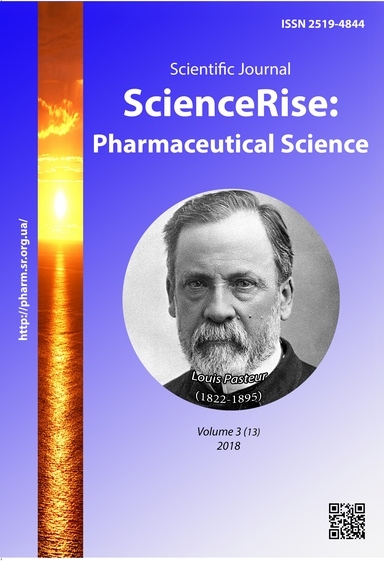Phytochemical and pharmacological study of polysaccharide complexes of prunus domestica fruit
DOI:
https://doi.org/10.15587/2519-4852.2018.135825Keywords:
plum, extract, polysaccharides, elements, histostructure, rats liver, ethanol intoxicationAbstract
Aim. The aim of our research was fractionation of polysaccharide complexes from fresh plum fruits, comparative study content of neutral sugars in it, element composition of plum fruit and investigation of influence of fibers and water soluble polysaccharide complex (WSPC) on histostructure of rats liver in conditions of ethanol intoxication
Methods. The elemental composition was determined with atomic emission spectrophotometer ISE 3500 (Thermo Scientific, USA). The content of polysaccharide fractions as fibers, WSPC and pectin was determined by Gravimetry. The comparative study of monosaccharides content in obtained fractions was carried out with picric acid method on a Hewlett Packard 8453 spectrophotometer at a wavelength of 463 nm in a cuvette with a layer thickness of 10 mm.
Investigation of the influence of fibers and water soluble polysaccharide complex (WSPC) of plum fruit on histostructure of rat liver was carried out on the model of ethanol intoxication.
Results. As a result of the study element composition were determined. Potassium has the most content in fruits– 2000 μg/100 g. Content of heavy metals in the plum fruit does not exceed the norms established by the State Pharmacopoeia of Ukraine. Three polysaccharide fractions, as fibers WSPC and pectines, were obtained from the fresh plum fruits. The most content of neutral sugars were determined in the WSPS – 61.52±1.47 %. Their content in other complexes was: in fibers – 59.23±1.15 %, pectin – 22.85±0.55 %.
It was confirmed that simultaneous administration of alcohol with the fibers of plum fruits in a dose of 200 mg / kg prevents the development of fatty dystrophy of the liver parenchyma, in contrast to the similar scheme of the administration of the WSPC of plum fruit in the same dose or drug comparison silibor at a dose of 30 mg/kg.
Conclusions. Considering results of phitochemical and pharmacological research we can assume that the plum fruit fiber is promising for further study in order to create a new effective and safe drugs for use in medical practice
References
- Chernykh, V. P. (Ed.) (2010). Farmatsevtychna entsyklopediya. Kyiv: MORION, 1952.
- Stickney, J. C., Van Liere, E. J., Northup, D. W. (1951). Correlation Between Propulsive Motility and Length of the Small Intestine in Albino Rats and Dogs. American Journal of Physiology-Legacy Content, 167 (2), 399–402. doi: http://doi.org/10.1152/ajplegacy.1951.167.2.399
- Celik, F., Gundogdu, M., Alp S., Muradoglu, F., Ercişli, S., Gecer, M. K., Canan, I. (2017). Determination of phenolic compounds, antioxidant capacity and organic acids contents of Prunus domestica L., Prunus cerasifera Ehrh. and Prunus spinosa L. fruits by HPLC. Acta Chromatographica, 29 (4), 507–510. doi: http://doi.org/10.1556/1326.2017.00327
- Senyuk, I. V., Bashar, A.-S. J., Lenchyk, L. V. (2017). Investigation of different substances catharic properties made from Prunus domestica. Ukrainian biopharmaceutical journal, 5 (52), 21–25. doi: http://doi.org/10.24959/ubphj.17.134
- Mohammed Shahm Basim, Lenchik, L. V., Caidov, N. B. (2017). Plody slivy domashney – perspektivnoe syr'e dlya sozdaniya lekarstvennyh sredstv. Nauka i innovaciya. Seriya estestvennyh nauk, 4, 42–48.
- The State Pharmacopoeia of Ukraine (2008). Kharkiv: RІRЕG, 620.
- Koshovyi, O. M., Zaitsev, H. P., Kovalova, A. M., Komisarenko, A. M. (2012). Doslidzhennia aminokyslotnoho ta monotsukrovoho skladu spyrtovoho ekstraktu z lystia evkaliptu prutovydnoho. Farmakom, 1-2, 46–49.
- Belousov, M. V., Cybukova, T. N., Berezovskaya, T. P., Tihonova, O. K., Basova, E. V., Zeyle, L. A., Yusubov, M. S. (2002). Elementniy sostav bagul'nika bolotnogo. Himiya rastitel'nogo syr'ya, 4, 35–38.
- Kabata-Pendias, A. (2010). Trace elements in soils and plants. New York: CRC press, 548. doi: http://doi.org/10.1201/b10158
- Merkulov, G. A. (1969). Kurs patologogistologicheskoy tekhniki. Leningrad: Medicina, 424.
- Serov, V. V., Lapish, K. (1989). Morfologicheskaya diagnostika zabolevaniy pecheni. Moscow: Medicina, 336.
Downloads
Published
How to Cite
Issue
Section
License
Copyright (c) 2018 Taras Upyr, Shahm Basim Mohammed, Al-Jabbar Ali Sahlani Bashar, Larysa Lenchyk, Igor Senyuk, Viktoria Kyslychenko

This work is licensed under a Creative Commons Attribution 4.0 International License.
Our journal abides by the Creative Commons CC BY copyright rights and permissions for open access journals.








